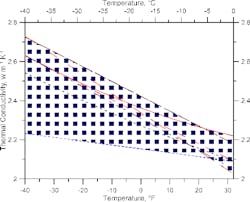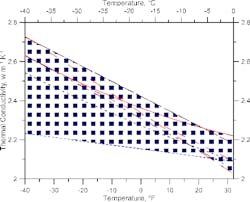Piping: Understand A Cold Fact About Ice
Walking around plants can identify many small improvements that can enhance profitability. One example comes from a refrigerated process plant that called me in for troubleshooting. An improperly operating unit there required considerable field work. In walking between the control room and the problem equipment, I noticed a lot of ice in many spots on the piping. In a cryogenic plant, ice signals heat gain from the environment; this adds load on the refrigeration system.
My first response was to comment that the plant could save energy or increase capacity by fixing the heat gain problem. The response came back: “We don’t worry about that — the ice insulates the piping.” The idea that ice acts as insulation is a common, but false, perception. In another plant, I was told: “Ice must be a pretty good insulator — Eskimos use it to build igloos.”
Today, many people turn to the Internet to quickly look up information. One engineer searching online for the insulation value of ice found a plethora of confusing data rather than clarity. That’s not surprising because many factors — including the rate of freezing, airborne contaminants present, entrapped air or gases, measurement technique and measurement device accuracy— affect the measured thermal conductivity of ice.
Figure 1. Broad variation in values reported in the literature can lead to confusion.
Figure 1 presents a range of reported values from different sources for the thermal conductivity of ice. At -40°F, the highest and lowest cited values differ by about 23%!
This certainly is enough of a difference to worry about if you are looking at food processing or Arctic engineering work on pipelines to prevent permafrost melting. However, does it really matter when it comes to the issue of ice insulating pipes in a refrigerated or cryogenic process plant? Not really — because the variance pales compared to the difference between the thermal conductivity of ice versus that of insulation materials.
As Table 1 shows, ice has roughly 100 times the thermal conductivity of economic thermal insulation materials. Ice isn’t a good insulator. In warm areas, ice comes from water condensed on a surface from the air around it. Condensation heat-transfer has enormously higher heat transfer coefficients than those of convection heat transfer. Ice on piping represents significant heat load for a refrigeration system.
Table 1. The thermal conductivity of ice is nowhere near that of common insulation materials.
Ice invariably indicates inadequacies in insulation practices at a plant. Insulation addition, replacement and repair always are worth the effort to prevent ice formation. Don’t let uncertainty about precise values of data prevent informed decisions.
This example provides another, perhaps even more important, lesson.
I created Figure 1 by reviewing seven datasets. Each plot represents the original correlations developed for the particular dataset. These correlations date back to 1922. Often, engineers don’t go back to the original work when verifying correlation data ranges but instead depend upon later summaries of the correlations.
Finding and verifying the data showed that one of the most recent summaries had two major flaws. First, the correlation given in the summary used the wrong temperature units; the authors had mixed up Kelvin with degrees Centigrade. Second, the summary transposed the intercept and slope values of another correlation for a linear curve fit. This summary didn’t appear in an Internet blog but in a reputable peer-reviewed journal.
The lesson here is that an engineer always should check the validity of calculation methods and data before using them. This might involve anything from a quick review of their reasonableness based on experience to a full statistical analysis of the data and correlations. The level of work will depend upon the criticality of the decision and the engineer’s experience level with the subject. The more important the determination and the less familiar the topic, the greater the need becomes to verify.



